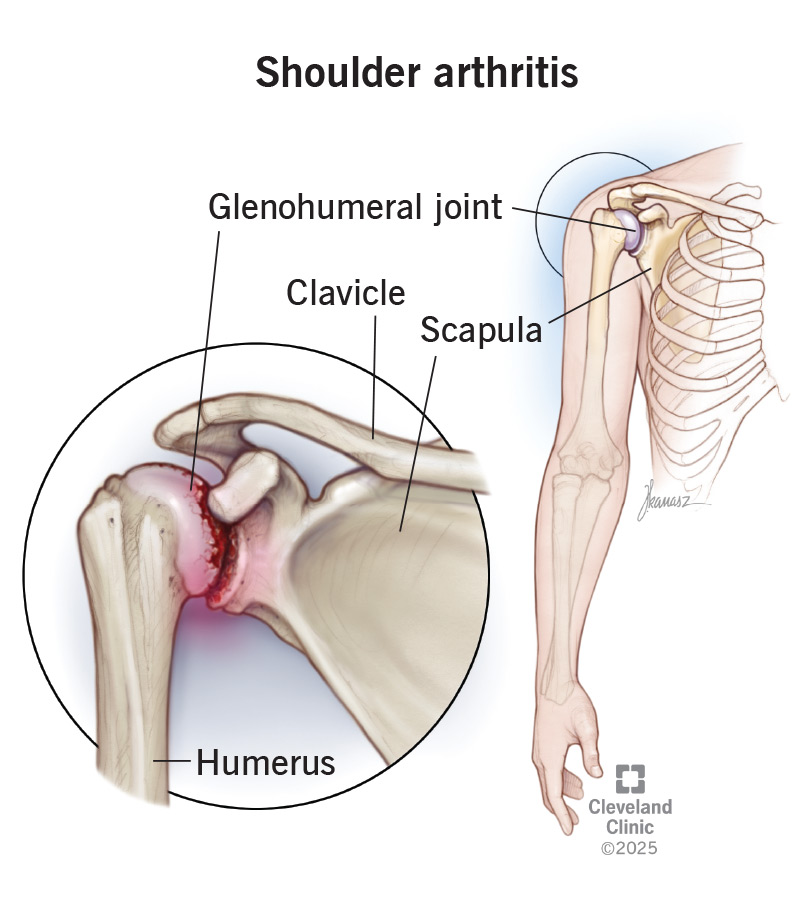Shoulder arthritis is inflammation in your shoulder joint. Over time, arthritis leads to cartilage loss. Symptoms include pain, stiffness, decreased range of motion and popping, clicking and grinding noises in your shoulder joint. Treatments range from pain-relieving home remedies — like ice, heat and exercises — to surgery.
Advertisement
Cleveland Clinic is a non-profit academic medical center. Advertising on our site helps support our mission. We do not endorse non-Cleveland Clinic products or services. Policy

Shoulder arthritis is inflammation in your shoulder joint that causes pain and stiffness. It makes lifting your arm uncomfortable and performing daily tasks extremely difficult.
Advertisement
Cleveland Clinic is a non-profit academic medical center. Advertising on our site helps support our mission. We do not endorse non-Cleveland Clinic products or services. Policy
Arthritis in the shoulder most commonly affects the “ball and socket” joint of your shoulder (glenohumeral joint). This joint is where the “ball” of your upper arm bone (humerus) rests against the “socket,” or cup, on the edge of your shoulder blade (scapula).
Over time, shoulder arthritis leads to cartilage loss. Cartilage is the tissue that covers the humeral head and the “socket” of your shoulder joint. Cartilage allows your bone surfaces to glide within your joints. It also cushions your bones against impact.
In the end stage of shoulder arthritis, without protective cartilage, bones in your shoulder joints rub directly against each other. Bone spurs can form, which block normal motion and can break off and become loose bodies within your joint.
There are four main stages of arthritis in the shoulder:
Advertisement
Shoulder arthritis symptoms vary from person to person. Symptom severity doesn’t always align with the level of cartilage damage.
Signs and symptoms may include:
If you have shoulder arthritis, you’ll feel mild-to-severe pain and stiffness in your shoulder. The pain is commonly located at the side of your shoulder, and the ache feels like it’s deep in your joint. Over time, you’ll notice a loss in your range of motion in your shoulder joint.
Shoulder arthritis has many possible causes. They include:
Shoulder arthritis is more likely to affect people:
Your healthcare provider will perform a physical exam of your shoulder, including checking your range of motion and strength. Your provider will also ask about your medical history and current symptoms.
Your provider may order imaging tests, including
Arthritis in the shoulder treatment options include home-based and lifestyle care, medications and surgery.
Treatment for shoulder arthritis usually begins with nonoperative, home-based and lifestyle care. These methods keep your shoulder mobile and reduce pain. These treatments include:
Advertisement
Medications relieve pain and reduce inflammation. Common options are:
If other treatment methods don’t relieve your pain and your arthritis is getting worse, surgery may be an option. Common surgical options include:
Your surgeon may consider variations of these main types of surgeries based on the type, location and severity of your arthritis. Your lifestyle, health history and personal preferences may also play a role.
Although there’s no cure for shoulder arthritis, there are many ways to ease your pain. You can use ice, heat and exercises to keep your shoulder loose and comfortable. Also, limit or avoid activities that are causing you pain. If these simple methods don’t relieve your pain, ask your healthcare provider about surgical options.
Advertisement
Your outcome depends on your age, activity level and the types and range of movements you make with your arm and shoulder. It also depends on the location, size and severity of your shoulder arthritis.
Because each person and shoulder situation is unique, ask your provider what outcome you can expect as you explore all treatment options.
You can lower your chances of developing arthritis in the shoulder by:
See your healthcare provider at the first sign of symptoms. If your shoulder problem is found early, you can learn ways to reduce pain, change or avoid certain activities, and reduce further cartilage damage.
Shoulder arthritis can hurt and affect the quality of your life. But just because there’s not a cure doesn’t mean you should live with the pain. Reaching out to your provider is the first step toward confirming the cause of your shoulder pain and developing a treatment plan that can best ease your symptoms. Your provider can help you find ways to spend more time doing the things you love and less time feeling stiff and uncomfortable.
Advertisement
When you have an inflammatory or autoimmune condition, you need experts by your side. At Cleveland Clinic, we’ll create an individualized treatment plan for you.

Last reviewed on 05/06/2025.
Learn more about the Health Library and our editorial process.